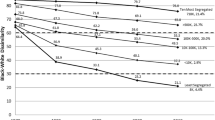Abstract
During the early 20th century, many Blacks in northern cities entered the retail trade, supposedly because residential segregation was advantageous to Black merchants. Building upon historical studies of Blacks in the urban North and upon the sociological literature on Black business enterprise, I use census data to analyze the relationship between (1) the spatial isolation of Blacks and (2) the representation of Blacks in the retail trade. I find that between 1900 and 1930 the association between these two variables became significantly positive. This finding corroborates historical case studies, and I conclude that after segregated Black communities emerged in northern cities at the end of the study period, spatial isolation did increase the participation of Blacks in the retail trade.
Similar content being viewed by others
REFERENCES
Aldrich, Howard, John Cater, Trevor Jones, David McEvoy, and Paul Vellman 1985 “Ethnic residential concentration and the protected market hypothesis.” Social Forces 63:996-1009.
Bates, Timothy 1973 Black Capitalism: A Quantitative Analysis. New York: Prager.
Boyd, Robert L. 1996a “Demographic change and entrepreneurial occupations: African Americans in Northern cities.” The American Journal of Economics and Sociology 55:129-143.
1996b “The Great Migration to the North and the rise of ethnic niches for African American women in beauty culture and hairdressing.” Sociological Focus 29:33-45.
1997 “The protected market hypothesis and ethnic residential segregation: The case of black undertakers in Northern cities during the Great Migration.” Paper presented at the 1997 Annual Meeting of the American Sociological Association, Toronto, Canada, August 9.
Brimmer, Andrew 1968 “Desegregation and negro leadership.” In Eli Ginzberg (ed.), Business Leadership and the Negro Crisis: 34. New York: McGraw-Hill.
Butler, John Sibley 1991 Entrepreneurship and Self-Help Among Black Americans. Albany: State University of New York Press.
Drake, Saint Clair and Horace Cayton 1962 Black Metropolis. (1945) New York: Harcourt, Brace and Company.
Du Bois, W. E. B. 1899 The Negro in Business. Atlanta, GA: Atlanta University Press.
1907 Economic Cooperation Among Negro Americans. Atlanta, GA: Atlanta University Press.
1973 The Philadelphia Negro. (1899) Millwood, NY: Kraus-Thomson Organization, Ltd.
Harmon, J. H. 1929 “The Negro as a local businessman.” Journal of Negro History 10:116-155.
Harris, Abram L. 1936 The Negro as a Capitalist. Philadelphia, PA: American Academy of Political and Social Science.
Higgs, Robert 1976 “Participation of Blacks and immigrants in the American merchant class, 1890–1910: Some demographic relations.” Explorations in Economic History 13:153-164.
1977 Competition and Coercion: Blacks in the American Economy, 1865–1914. Cambridge: Cambridge University Press.
Katzman, David M. 1973 Before the ghetto: Black Detroit in the nineteenth century. Urbana, IL: University of Illinois Press.
Kinzer, Robert H. and Edward Sagarin 1950 The Negro in American Business: The Conflict Between Separatism and Integration. New York: Greenberg.
Kusmer, Kenneth L. 1976 A Ghetto Takes Shape: Black Cleveland, 1870–1930. Urbana: University of Illinois Press.
Landry, Bart 1987 The New Black Middle Class. Berkeley: University of California Press.
Lieberson, Stanley 1980 A Piece of the Pie: Blacks and White Immigrants Since 1880. Berkeley: University of California Press.
Light, Ivan 1972 Ethnic Enterprise in America. Berkeley: University of California Press.
Light, Ivan, and Stavros Karageorgis 1994 “The ethnic economy.” In Neil J. Smelser and Richard Swedberg (eds.), The Handbook of Economic Sociology: 647-671. Princeton, NJ: Princeton University Press.
Marks, Carole 1989 Farewell—We're Good and Gone: The Great Black Migration. Bloomington: Indiana University Press.
Massey, Douglas S. and Nancy A. Denton 1993 American Apartheid: Segregation and the Making of the Underclass. Cambridge, MA: Harvard University Press.
Meier, August 1963 Negro Thought in America, 1880–1915: Racial Ideologies in the Age of Booker T. Washington. Ann Arbor: University of Michigan Press.
Model, Suzanne 1993 “The ethnic niche and the structure of opportunity: Immigrants and minorities in New York City.” In Michael B. Katz (ed.), The “Underclass” Debate: Views From History: 161-193. Princeton, NJ: Princeton University Press.
Myrdal, Gunnar 1944 An American Dilemma. New York: Harper & Row.
Oak, Vishnu V. 1949 The Negro's Adventure in General Business. Westport, CT: Negro Universities Press.
Osofsky, Gilbert 1966 Harlem: The Making of a Ghetto. Negro New York, 1890–1930. New York: Harper & Row.
Pierce, Joseph 1947 Negro Business and Business Education. New York: Harper and Brothers.
Portes, Alejandro, and Leif Jensen 1987 “What's an ethnic enclave? The case for conceptual clarity” (Comment on Sanders and Nee). American Sociological Review 52:768-771.
Sowell, Thomas 1981 Ethnic America: A History. New York: Basic.
Spear, Allan H. 1967 Black Chicago: The Making of a Negro Ghetto, 1890–1920. Chicago: University of Chicago Press.
United States Bureau of the Census 1904 Special Reports: Occupations at the Twelfth Census. Washington, DC: U.S. Government Printing Office.
1914 Census of Population: 1910, Volume 4. Occupational Statistics. Washington, DC: U.S. Government Printing Office.
1923 Census of Population: 1920, Volume 4. Occupations. Washington, DC: U.S. Government Printing Office.
1933 Census of Population: 1930, Volume 4. Occupations by States. Washington, DC: U.S. Government Printing Office.
Waldinger, Roger, and Howard Aldrich 1990 “Trends in ethnic business in the United States.” In Roger Waldinger, Howard Aldrich, and Robin Ward (eds.), Ethnic Entrepreneurs: Immigrant Business in Industrial Societies: 49-78. Beverly Hills, CA: Sage.
Waldinger, Roger, David McEvoy, and Howard Aldrich 1990 “Spatial dimensions of opportunity structures.” In Roger Waldinger, Howard Aldrich, and Robin Ward (eds.), Ethnic Entrepreneurs: Immigrant Business in Industrial Societies: 106-130. Beverly Hills, CA: Sage.
Washington, Booker T. 1907 The Negro in Business. Boston: Hertel.
Wilson, William Julius 1978 The Declining Significance of Race. Chicago: University of Chicago Press.
Author information
Authors and Affiliations
Rights and permissions
About this article
Cite this article
Boyd, R.L. Residential Segregation by Race and the Black Merchants of Northern Cities During the Early Twentieth Century. Sociological Forum 13, 595–609 (1998). https://doi.org/10.1023/A:1022843300237
Issue Date:
DOI: https://doi.org/10.1023/A:1022843300237




